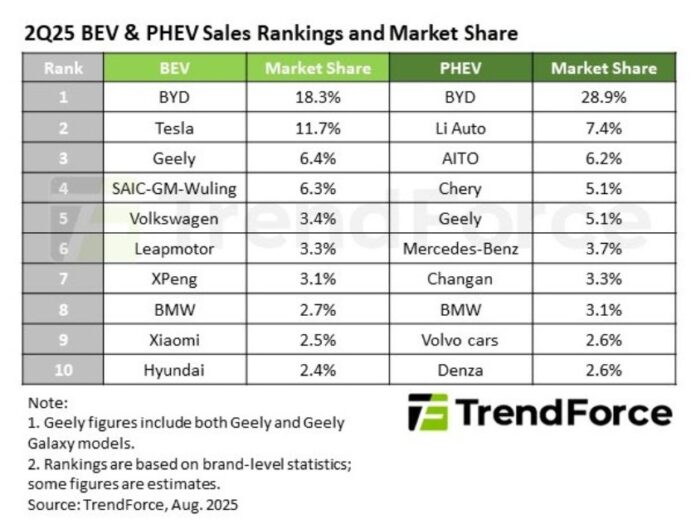In the second quarter of 2025, BYD continued to dominate the global EV market, leading both BEV and PHEV segments with market shares of 18.3 percent and 28.9 percent, respectively. Tesla held the second position in the BEV market with 11.7 percent, while Li Auto was second in PHEVs at 7.4 percent.
Geely, including its Galaxy models, secured the third position in both categories, with 6.4 percent in BEVs and 5.1 percent in PHEVs. SAIC-GM-Wuling followed closely in BEVs at 6.3 percent, while AITO ranked third in PHEVs with 6.2 percent.
Other notable BEV players included Volkswagen (3.4 percent), Leapmotor (3.3 percent), XPeng (3.1 percent), BMW (2.7 percent), Xiaomi (2.5 percent), and Hyundai (2.4 percent). In PHEVs, Chery achieved 5.1 percent, Mercedes-Benz 3.7 percent, Changan 3.3 percent, BMW 3.1 percent, and both Volvo Cars and Denza held 2.6 percent each.
The data from TrendForce highlights BYD’s strong lead across both EV categories, with Tesla maintaining solid BEV performance and Chinese automakers driving much of the competition in both markets.
How BYD strengthened EV share
BYD has strengthened its dominance in the global battery electric vehicle (BEV) market in the second quarter of 2025, securing an 18.3 percent share and posting a robust 43 percent year-on-year sales growth. The surge was driven by strong demand across its diverse lineup, competitive pricing, and a strong foothold in China, enabling the company to attract both entry-level and premium buyers.
While BYD’s plug-in hybrid (PHEV) sales fell 12 percent due to tougher competition from Chinese rivals such as Li Auto and AITO, its BEV momentum and sub-brand performance offset the dip. Denza reported a 41 percent jump in sales following the launch of its high-end N9 model, while Fangchengbao tapped into niche off-road performance segments. By balancing affordability with innovation and leveraging supportive government policies, BYD has managed to consolidate its market leadership and widen its lead over competitors.
Tesla, meanwhile, retained second place but faced a 14 percent drop in sales compared to last year. The company struggled in its most critical markets — China, North America, and Western Europe — where intensified competition, policy shifts, and limited model diversity weighed on performance. Although Tesla saw gains in smaller markets including South Korea, Norway, and Turkey, these were not enough to offset declines in its major geographies.
Industry analysts note that Tesla now faces mounting pressure as Chinese automakers such as BYD, Geely, Leapmotor, and Xiaomi expand aggressively with broader, more affordable product portfolios. Tesla’s key challenge will be to refresh its lineup, regain lost ground in China, and navigate shifting subsidy regimes in both the US and Europe to maintain its global position.
GreentechLead.com News Desk

